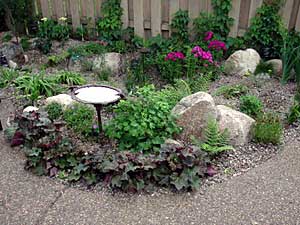|
Audio
Photos
Resources
Your Voice
|
Minneapolis residents build rain gardens
August 1, 2003
 |
| A rain garden in Minneapolis' Fulton neighborhood. The rain gardens are part of a pilot project to find alternative ways to manage stormwater runoff. (MPR Photo/Mary Losure) |
Minneapolis, Minn. — Maxine Linehan lives in a low-lying area of the Fulton neighborhood, south of Lake Harriet. Well-kept houses front her shady, tree-lined avenue. But during hard rainstorms, the street has serious problems.
"We have one neighbor on Drew, that when our streets flood he has been known to take his canoe and have a ride down Chowen Avenue. It's been really awful," says Linehan. "One of the worst things that they were proposing was to remove the boulevard trees, and put large holding tanks under the boulevards in place of that. And the people didn't want that to happen."
So Linehan's been pioneering a different way of dealing with storm water runoff -- rain gardens.
 | |||
Hers is a slightly sunken oval about 12 feet long. When it rains, the water from her garage downspout runs into the pool. It sit there for an hour or so before soaking into the soil.
She dug the pool herself with a shovel. She planted it with ferns, sedges, and wildflowers.
"They're being established now. I just planted them in May and June. But they're special native plants and they're selected because of our location and our soil. They do well in a shady location like we have here," says Linehan.
"Some of the rain gardens are using prairie plants because they have a sunnier location. Most of the native plants have very deep root systems, sometimes eight feet, and so eventually when the roots get established, the roots will help the water drain down deeper into the soil," she says.
 | |||
Linehan's garden is one stop on a free, self-guided rain garden tour, organized by the Fulton Neighborhood Association. The group secured grant money to help fund six rain gardens in the neighborhood.
Natalie Hallyn took the tour Thursday. She's a landscape designer who's helping with a program to build rain gardens in her Minneapolis neighborhood near the University of Minnesota. She says even though the gardens' primary benefit is collecting rainwater, their beauty is what draws her.
"The rain garden can look so different in all the different seasons," says Hallyn. "It just kind of brings out a little bit of what Minnesota used to look like before we paved the whole area, before it became all just concrete and turf grass and street trees."
Hallyn's neighborhood is working on plans to install demonstration pavements that are not impermeable to rainwater. They’re even thinking of a garage roof that will be covered with soil and planted, the way some roofs are in Europe.
 | |||
Others on the tour had less ambitious goals. Mark Smith was just looking for some ideas for keeping water out of his basement. He'd been thinking of something along the lines of a rain garden, and was impressed at what he'd seen so far.
"I looked at the one on the other street and I was surprised at how pretty it was, and how non-obvious its function was. It wasn't like it was this pit that was supposed to hold the water," says Smith.
The Fulton Neighborhood Area rain garden tour runs through August 3.
|
News Headlines
|
Related Subjects
|
